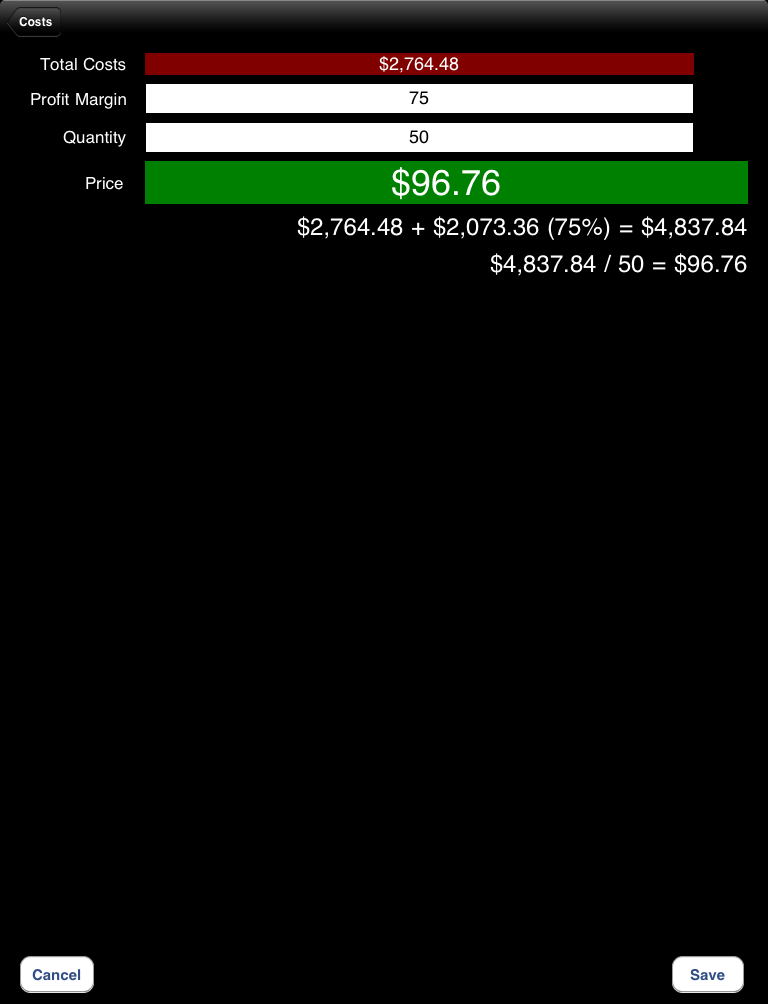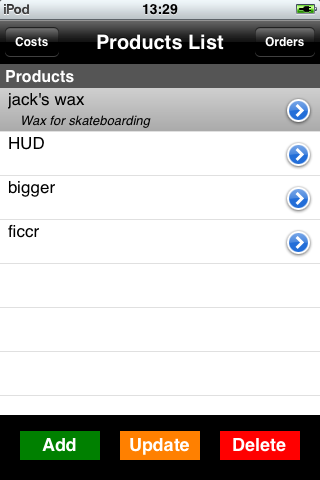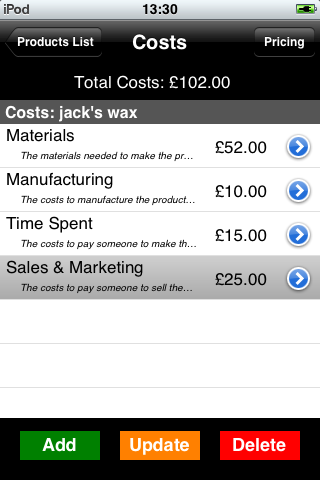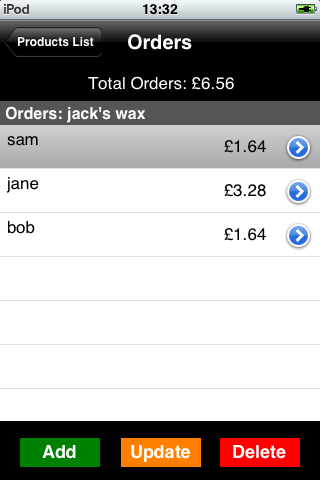Current Activity
Jim Chapple is now working full time on iphone/ipod touch and iPad applications.
Jim Chapple also works on Mac OS X Apps.
Please email Jim Chapple for support issues, information and quotes.
Product Pricing
- Create a Product, determine its costs, select the markup percentage and the number of units to be created and this App will tell you what the price per unit is.
- Each product can also have orders recorded for it with the price calculated for the order based on the number of units ordered.
- You can have as many or as few costs recorded for a product. If prices change then you can easily update them. If a cost is no longer necessary then it can be deleted.
- You can set the markup percentage for the product to whatever value you want. All that is then required to calculate the price for a unit of the product is how many of the units can be made for the costs specified. Once this is known the App tells you what the price will be.
The small thumbnail images below will show larger iPad screenshots.






FAQ: This App does not work properly it keeps on crashing, why?
Sometimes Apps just do not download properly. You will need to download it again, for free, using itunes. See Apple Support Pages
About half way down the page there's a set of instructions that starts 'Reinstall the affected application'.
Once iTunes has it then you sync your device and it should then work. If it does not then please to contact me.

When the Application StartsThe App initialises itself to read all the saved information about Products, Costs and Orders. Obviously the first time it starts there are no saved items so the Application starts with no Products specified. To start all you have to do is to select the 'Add' button at the bottom of the screen. This takes you to the Add Product Page. You can have as many Products as you want. A product has a unique name and optional notes. Once a product has been created you can go back to it to change its name or add/update/delete notes. The basic information for each product is shown in the table with the title at the top and underneath the start of the notes. To the right is a button that takes you to the Update Product Page. This can also be reached by selecting the product in the table and selecting the 'Update' button. If you decide you do not want a product any more then select the product in the list and then select the 'Delete' button. There is a confirmation dialog to stop you from accidentally deleting the product. When you delete a product you also delete all the costs, the pricing information and the orders that are for that product. To see the costs for a Product select it in the list and then select the 'Costs' button at the top. To see the orders for the it select the 'Orders' button instead. |

The Costs PageThis page shows you the costs for the selected Product and at the top the total of all of those costs. When a product is created four default costs are added. Each has a value of zero (in this screenshot they have been changed but they will be zero to start). These have been added to remind you of the basic costs that need to be considered when costing a product. If you do not include all the possible costs then the final price will not be correct. You can delete these costs if you want or use them as a starting point for all the product's costs. Pressing the 'Add' button takes you to the Add Cost page. Selecting a costs in the list and either pressing the details icon or selecting the 'Update' button takes you to the Update Cost Page. Selecting a cost and pressing the 'Delete' button shows a confirmation dialog asking whether you really want to delete the cost. If you select Yes then the cost is deleted from the product. The total costs reduce and the calculated price changes accordingly. The costs table shows each cost with the start of any notes and the value of that cost. You can have as many costs as you like. |

The Pricing PageOnce you have determined the costs for a product you can determine the price per unit. To do this you select the 'Pricing' button at the top of the Costs Page. At the top of this page is shown the total costs of the product. Below this is the required profit margin and below that the number of units that can be made for the costs specified. The profit margin is probably the easiest value to set but the hardest to get right. The Quantity (number of units) value can be one of the hardest to determine because it is based on the costs you specified. If you bought enough materials for 100 units then you should put 100. The best thing to do is to set the quantity to the value you initially believe you can make and set a reasonable profit margin (the default is 100%). This will generate the price per unit. Below the price per unit are two labels that show you how this value was arrived at. Basically, take the costs add on the profit margin and then divide by the qunatity. This is the initial price. When you then make the product you may find that you cannot make 100 and so you should change the quantity you did make. This may be higher or it may be lower. If the price per unit is too high then either: the costs are too high, the profit margin is too high or the number of units being made is too low. So reduce costs, reduce you profit margin or increase the number of units made for the same costs. Some or all or none of these may be possible. Maybe the product just cannot be made for a reasonable price! If the price per unit is too low then either: the costs are too low, the profit margin is too low or the number of units being made is too high. You may not have added all the costs, maybe you could increase you profit margin (not a bad thing) or maybe you have over-estimated the number of units that can be made for the costs specified. If you think the costs are correct and the quantity correct and you still want the price to be higher then increase the profit margin. Select 'Save' to save these new numbers. Select 'Cancel' to discard them. |

Add/Update Cost PageOn this page you can specify the title for the cost, how much it is and any notes that you want. Select 'Save' to save the new cost. Select 'Cancel' to either not create a new cost or to not update the cost you were editing. If a new cost is added then it is added to the top of the costs for the product. The total value of all the costs is changed to show the additional cost. If it is updated then the information is changed for the updated row and the total value of the costs changed. |

The Orders PageThis page shows you the orders for the selected Product and at the top the total value of all of those orders. Pressing the 'Add' button takes you to the Add Order page. Selecting an order in the list and either pressing the details icon or selecting the 'Update' button takes you to the Update Order Page. Selecting an order and pressing the 'Delete' button shows a confirmation dialog asking whether you really want to delete the order. If you select Yes then the order is deleted from the product. The total value of the orders is reduced accordingly. The orders table shows each order with the start of any notes and the value of that order. You can have as many orders as you can get. |

Add/Update Order PageOn this page you can specify the name for the order, how many units are orders and any notes that you want. Select 'Save' to save the new order. Select 'Cancel' to either not create a new order or to not update the order you were editing. Next to the number of units ordered is the calculated value of the order and how it was calculated. This is calculated from the price per unit multiplied by the quantity ordered. If a new order is added then it is added to the top of the orders for the product. The total value of all the orders is changed to show the additional order. If it is updated then the information is changed for the updated row and the total value of the orders changed. |
